In late June, US Copyright Office announced an upcoming change in procedures for copyright registration of groups of “short literary works” (between 50 and 17,500 words), which we can, in a bit of shorthand, understand as basically referring to collections of blog posts.
This procedural change comes after a multi-year study and public comment period. The problem, as urged by bloggers, is that applying for copyright registration for their frequent, short (1000 words or so) works is infeasible and too costly under the procedures as they stand for more traditional literary works such as books and poems. Under the new rules, bloggers will be able to register up to 50 of their posts in a single online submission, at the standard rate of $55. Basically, the same route which has been available to photographers for several years is now available to bloggers.
Before you ask: Postings to this blog are normally “works made for hire,” and the copyright belongs to CCC. We don’t make applications to register these, but now we could do so in batches of 50!
The Copyright Office has begun its eighth triennial rulemaking proceeding under 17 U.S.C. § 1201, which entails a new round of public comments concerning exemptions to the DMCA’s “anticircumvention” restrictions. Every three years, the Copyright Office reruns this procedure, granting some requests for exemptions and not others. “Jailbreaking” (or, more neutrally, “unlocking” one’s mobile phone is regulated under this process, while decrypting computer programs for legitimate security testing and certain uses of portions of film or video works in digital format (e.g. DVDs) in classroom settings remain authorized under certain conditions. As technology changes, petitioners have this regular opportunity to request exemptions that, if granted, rule their activities as non-infringing, at least for the following three years. And that’s a good thing.

Another aspect of copyright regulation put into place by the (now more than 20-year-old) DMCA is the “Notice & Takedown” process to protect copyrighted content uploaded to online content platforms such as YouTube and Facebook. Many creators, as well as many users and indeed the platform hosts themselves, complain of unhappy results under the existing process. As current head of the Senate Judiciary IP Subcommittee, Thom Tillis of North Carolina is spearheading, along with Senator Pat Leahy of Vermont, hearings and a study of the current status of these issues with an eye towards addressing them legislatively in the next session. One annoying problem of especial interest to individual creators and publishers is what is termed the “whack-a-mole” problem. Typically, notice of infringing content on one site is provided, and the material is taken down; but, like the moles parodied in the arcade game, the material pops right back up on another site. And another, and another . . . . In 2016, YouTube was estimated as having to process more than 2 million takedown requests per day. The one-at-a-time Notice & Takedown procedure is clearly not doing its job of remedying the problem. Time for an update?

